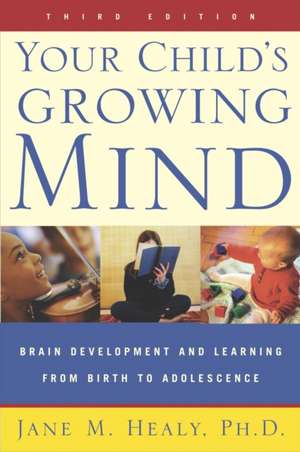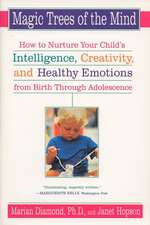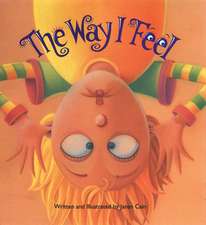Your Child's Growing Mind
Autor Jane Healyen Limba Engleză Paperback – 24 mai 2004
Hailed by parents and educators, Your Child’s Growing Mind is a window into the fascinating process of brain development and learning. It looks at the roots of emotion, intelligence, and creativity, translating the most current scientific research into practical suggestions for parents and teachers.
Dr. Healy also addresses academic learning, offering countless suggestions for how parents can help without pushing. She explains the building blocks of reading, writing, spelling, and mathematics and shows how to help youngsters of all ages develop motivation, attention, critical thinking, and problem-solving skills.
Using the science of childhood development, she also examines today’s hot issues, including learning disabilities, ADHD, influences of electronic media, and the hazards of forced early learning. From infancy to adolescence, this is the perfect guide to helping and enjoying a youngster’s mental, personal, and academic growth.
Preț: 123.57 lei
Nou
23.64€ • 24.64$ • 19.58£
Carte disponibilă
Livrare economică 13-27 martie
Specificații
ISBN-10: 0767916158
Pagini: 432
Ilustrații: illustrations
Dimensiuni: 135 x 215 x 30 mm
Greutate: 0.38 kg
Ediția:Revised
Editura: HARMONY
Recenzii
“A sane and readable guide to the burgeoning literature on human development. I particurly liked the discussions on the perils of superbabying and on the fostering of creativity.” —Dr. Howard Gardner, author of Frames of My Mind and The Mind’s New Science
"Dr. Healy has done it again with Your Child's Growing Mind. Noboday Makes child development and it's practical applications so clear and readable. A must for parents." –Michael Brody, M.D., Chair of The Television and Media Committee of The American Academy of Child and Adolescent Psychiatry
"This book became an instant classic when it was published in 1987, and has been a cornerstone for educators ever since. Now revised and updated to reflect recent findings in brain research, this book guides parents, teachers, and caregivers as they gauge the level of development of an individual child's brain." –Ingram
Notă biografică
JANE M. HEALY, Ph.D., is an educational psychologist and teacher who has worked with students from preschool through graduate school. She consults and lectures worldwide, helping teachers and parents understand the educational implications of current brain research. She has appeared on national media such as the Today show, Nightline, Good Morning America, CNN, and NPR. A mother and grandmother, she currently lives in Vail, Colorado.
Extras
Opening the "Black Box"
One evening some years ago, I received a call from a young teacher whom I hadn't seen since she had left school on maternity leave. We had often talked about her hopes and plans for the baby, but tonight she sounded worried.
"Jane, I'm sorry to call you at home, but I just have to ask for some advice about Tony. He seems very advanced, and I'm doing all the things we talked about--playing with him, talking to him, reading to him--but this neighbor of mine has just signed up for a course that advertises ways to raise her child's IQ by increasing his brain development. Should I be doing more? Can parents really help build their kids' brains?"
Amy's call didn't surprise me, since over the years I have gotten the same question in many forms. The pressure on parents becomes more intense all the time. They come to my office wanting to do a "perfect" job despite the constraints of busy schedules, but they are confused by conflicting theories about child development and by omnipresent advertising for products that claim to make children smarter sooner. Confusion and guilt are inevitable: Am I doing enough? How much and what kind of enrichment does a preschooler need? What is the best way to teach reading and math--and what if my child is having difficulty? Should parents help with schoolwork? Can creativity be developed? How can we act as a child's advocate if school personnel aren't attuned to individual needs? What, really, is "attention deficit disorder"? How can we make kids more motivated? What about the child who doesn't "fit the mold"?
These questions have never been easy ones, but now the science of developmental neuropsychology, integrating brain research with children's behavior and learning, offers some answers. We know more about learning, individual differences in abilities, and emotional development than we did even five years ago. Although no two human brains are alike and no one set of answers is right for every child, new information can help teachers do a better job and assist parents in making wise decisions--while confirming the innate wisdom of their own best instincts. An incident much earlier in my career makes me realize just how far we have come.
I met nine-year-old Aaron when he tripped over me as he was entering his science class. As a visiting consultant, I was trying to be invisible, and apparently I had succeeded as far as Aaron was concerned. I began to suspect that this waifish-looking little fellow had a problem when he next bumped into the doorway, scattering a mass of smudged work sheets whose mangled manuscript letters would be an embarrassment to most six-year-olds and which bore the indelible marks of teacher rejection: "Messy!" "F." Ignoring my mission to evaluate the science curriculum, I watched him struggle to organize himself around a desk, dropping his pencil and fumbling through a tattered folder for misplaced homework. A discussion of space exploration immediately attracted his attention, and his skinny arm gyrated in the air, once more knocking his pencil, unnoticed, from the desk. Recognized at last by the teacher, he delivered a stunning exposition of rocket trajectories, fuel needs, and relative astral distances.
I couldn't resist asking the principal about Aaron. "Has he ever had a neurodevelopmental evaluation? It sure looks as if something is misfiring when he tries to translate his good ideas into action."
"Oh, no," he said. "Poor kid has an emotional problem. He's being treated by a psychiatrist. Believe it or not, he still wets his bed! His mother rejected him emotionally when he was born, and he's always had difficulty with schoolwork even though we can tell he's smart."
"Well, you might consider looking further," I ventured. I was quite sure Aaron had some problems that predated the emotional ones, but I was there to evaluate curriculum, not to do diagnosis.
Six months later I received a note in the mail from a woman who identified herself as Aaron's mother. "Thanks to your intervention," she said ("intervention," indeed!), "we took Aaron to a clinic and found that he has had a problem since birth in one of the important lower brain centers." Since the area she described is part of a system responsible for voluntary control of motor movements such as writing, avoiding bumping into people and doorways, and yes, even bladder control, it is not surprising that Aaron was having problems despite an IQ in the superior range. "Now we understand that he isn't lazy or stupid, and he will get special help with this problem," she went on to say. "If you only knew the guilt and the anguish we have been through, you would understand why I am so grateful."
I keep that note, not only because it is the only effortless success story of my career, but also because it is a perfect example of the "black box" view of the brain that prevailed for so long: "If we can't see inside, we'll ignore it." "Emotional problems" became the handiest scapegoat whenever things weren't going well. The unfortunate result became a "blame game" in which the parents, school, and even the child were accused of responsibility for problems in learning. We have come a long way, but the "blame game" is still around--for parents, for children with learning differences, for some whose environments shortchanged them early in life, and too often for educators who can't force unprepared or unready neural systems to mature on a set timetable.
Looking Inside
Various forms of brain research have been conducted for centuries, but the field has experienced an avalanche of new information since the development of electronic methods of observing and measuring brain activity. Harmless ways of looking directly at the brain in action help teach us about why learning happens--or fails to. The major methods of looking inside utilize either caps of electrodes or computerized scanners. Mapping the brain's electrical activity shows how actively and how quickly brain areas respond to a stimulus; different kinds of scanners display the structure of the brain or the way it functions during normal activities, such as reading or working mental problems. Because these technologies are still difficult to use in real-life situations (in a scanner, for example, the child must lie still for an extended period of time), their findings are combined with behavioral observation and good educational and developmental research to get a bigger picture.
From another angle, work with "artificial intelligence" has also sparked research on how the human brain functions, giving scientists new respect for the capabilities and complexity of even a toddler's brain as they try--and fail--to duplicate human learning abilities, such as building a block tower. Computer brains are terribly good at some things, but terribly bad at others--such as creativity, understanding the nuances of language, or practical problem-solving. Nor can they compete with human caregivers in providing "scaffolds" for a child's social, emotional, and cognitive growth.
The purpose of this book is to bring you up to date by explaining what science has discovered and how we can apply it in real-life situations at home or school. I will be drawing on research in a wide variety of fields and on a background of professional and personal experience. I hope you will also feel empowered to use your own common sense! In this chapter we will introduce two major questions central to the book: Where does brainpower come from, and what can we do about it? The following chapters will apply this basic information to different age groups and to specific aspects of personal development, learning fundamentals, and academic achievement.
BRAINPOWER: UNDERSTANDING THE BASICS
Overview: Brain Structure vs. Function
Frank Lloyd Wright, the famous architect, is said to have used the phrase "form follows function" to make the point that the way a structure is to be used should determine the way it gets shaped. This principle definitely holds true for the human brain. The way your children--or students--use their brains will help determine the shape and power of neural connections.
The basic structure of the brain--its architecture--is composed mainly of cells called neurons and their supporting cells. Its function, on the other hand, is a dynamic process that involves the way these neurons communicate through electrical and chemical signaling. As relays between cells are repeatedly made, they create complex physical networks of connections--which in turn become part of the structure of the brain. In this sense the brain is "plastic," literally shaping itself according to what it responds to.
Where Does It Come From?: Heredity and Environment
"I'm not surprised that Sally is having trouble with math." Her mother, Mrs. Strang, was apologetic. "I was hopeless in math even though I was a good student otherwise." Sally, now a fifth grader who had just won the school spelling contest, was struggling mightily with her math assignments, particularly those involving "story" problems, charts and graphs, and geometric forms. We decided to ask Sally's math teacher to work individually with her after school, and her mother agreed that they would practice together at home with some materials designed to improve concepts of space relationships. As Mrs. Strang left my office, I noticed that she first turned in the wrong direction before she started down the hall, and I recalled a much earlier conversation in which she confided that she didn't let Sally climb trees for fear she would hurt herself.
Did Sally inherit her math problem? Did she pick it up from poor teaching? Can we blame it on a lack of experience with physical and space relationships in her early years? How about her best friend, Megan, who started to read and calculate when she was three and gets straight As with very little effort? Was she born smart or did her parents do something right? Should we switch the "blame game" to parental genes?
Does heredity ("nature") or environment ("nurture") play the major role in development? There is such a constant interaction between basic capacity and experience from the moment of a baby's conception that the question is impossible--and really unnecessary--to answer. Every child inherits a physical brain structure and a timetable for development as well as chemical and electrical response patterns that strongly influence its functioning. A child's personal tempo--the natural pace of responding and the speed of carrying out activities--also seems to be genetically determined.
Other inherited dimensions of personality have their roots in the brain, such as introversion or extroversion. Some children are shyer, while others are more outgoing and people-oriented from the beginning, behaviors that reflect activation in opposite sides of the brain in new or challenging situations. An easy or difficult disposition related to the balances of brain chemicals may also come with the package. The tendency to act impulsively, linked to the function of a specific area of the front part of the brain, seems to be present in some families, although you will learn later how envionments affect this behavioral style. Family patterns for the timetable of physical and intellectual development make some children pass through the stages of growth more quickly than others, although more rapid maturation does not necessarily predict a better final outcome.
Certain constellations of abilities, such as music, engineering, or literary talent, seem to cluster in some families; there are also some types of learning problems, such as developmental dyslexia, which are hereditary and involve specific differences in brain structure and function. Nevertheless, in the case of dyslexia, the language environment at home and the type of reading instruction a child gets can determine the severity of the problem and even how the brain functions during reading.
Studies of identical twins, who have identical genes, have also demonstrated the inherited stability of some aspects of intelligence even when the twins are raised separately. Since many different genes are involved in intellectual ability, it is not easy to pin down this complex phenomenon. Some severe psychological problems, such as depression or schizophrenia, also have a genetic component (both structural and biochemical differences have been found in these brains), although identical twins often differ in whether they become schizophrenic, suggesting involvement of environmental factors as well.
A Two-Way Street
The child's personality and response style also help determine the way he gets treated by those around him. Some children are just plain "difficult," and some are harder for parents to relate to because they are temperamentally very different from the rest of the family. Naturally, their behavior increases the stress, and thus affects the response, of the adults in their life. No doubt Aaron was one of these youngsters. Understanding the problem enables us to help such children while making the parent's role an easier one.
What accounts for Sally's math problem? Undoubtedly a combination of factors. Rather than trying to pin responsibility on genes or early experiences, our job is to appreciate her particular way of learning and provide new experiences to enhance it. In short, neuropsychologists tell us that the human brain comes into the world programmed for certain aspects of learning and behavior, but many of these are susceptible to alteration.
Now, as a prelude to understanding what we can do about helping children develop their own brainpower, let us turn to some basic ideas about how the brain is structured, how it functions and grows, and how it directs learning.
THE DEVELOPING BRAIN
A Tough Start
One of my most poignant recent experiences involved kids who experienced a really tough start in life. I was invited to present a workshop at a conference hosted by an international group of parents of adopted Romanian orphans. The plight of these youngsters has been well-publicized, as it is one of the most appalling examples of child neglect and abuse ever uncovered. Committed to grossly understaffed orphanages by desperately poor parents, these children were fed gruel out of bottles and confined in cribs--sometimes for years. Many lacked even minimal interaction with adults or peers, physical or emotional stimulation, language, toys, or any of the other necessities we normally take for granted.
These cases have provided a tragic study in the developmental consequences of early deprivation. Indeed, depending on the age of adoption and the child's condition at that time, it appears that some aspects of brain functioning may have been compromised beyond recovery. On the other hand, as I made my way to conference sessions through a playful and energetic bunch of kids and parents, I was astonished at the amount of recovery that had obviously taken place. The parents I met, as a group, were singularly devoted to these children; many had provided countless hours and varieties of expert remediation--in some cases starting almost from scratch. Most important, of course, they had also provided vast quantities of love and emotional support--a most inspiring group of people!
I was particularly struck by the parents' reports that, although many of the children were struggling with various types of learning problems, many had overcome major cognitive obstacles. The main barrier to "catch-up" was in the social and emotional realm--particularly the ability to relate effectively with loved ones or friends. Whether or not some of these youngsters will ever be able to overcome that handicap is an unanswered question, since there are "critical periods" early in life for such basic emotional and personal qualities. The good news is that many of these children were still making progress, even after a neural window of opportunity was presumably closed.
Descriere
The classic guide to understanding children’s mental development is now updated and better than ever!
Hailed by parents and educators, Your Child’s Growing Mind is a window into the fascinating process of brain development and learning. It looks at the roots of emotion, intelligence, and creativity, translating the most current scientific research into practical suggestions for parents and teachers.
Dr. Healy also addresses academic learning, offering countless suggestions for how parents can help without pushing. She explains the building blocks of reading, writing, spelling, and mathematics and shows how to help youngsters of all ages develop motivation, attention, critical thinking, and problem-solving skills.
Using the science of childhood development, she also examines today’s hot issues, including learning disabilities, ADHD, influences of electronic media, and the hazards of forced early learning. From infancy to adolescence, this is the perfect guide to helping and enjoying a youngster’s mental, personal, and academic growth.



















